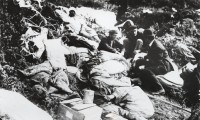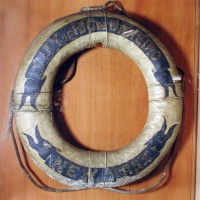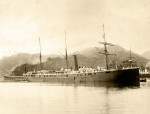 When the SS City of Rio de Janeiro struck the shoals of Fort Point in San Francisco Bay early morning on February 22, 1901, 128 of the 210 souls aboard perished. It was 5:00 AM and the Bay was wrapped in one of those blinding fogs that are its trademark. Visibility was literally zero. Captain William Ward tried to steer the 345-foot steamer through the Golden Gate but with no visible landmarks, he veered slightly too far south and the ship ground onto the jagged rocks. The underside of the vessel was torn open almost from stem to stern, and when the ebb tide pushed the ship off the shoals, the cargo holds and engine room flooded. Built in 1878 before the era of watertight bulkheads, City of Rio was under the waves in 10 minutes.
When the SS City of Rio de Janeiro struck the shoals of Fort Point in San Francisco Bay early morning on February 22, 1901, 128 of the 210 souls aboard perished. It was 5:00 AM and the Bay was wrapped in one of those blinding fogs that are its trademark. Visibility was literally zero. Captain William Ward tried to steer the 345-foot steamer through the Golden Gate but with no visible landmarks, he veered slightly too far south and the ship ground onto the jagged rocks. The underside of the vessel was torn open almost from stem to stern, and when the ebb tide pushed the ship off the shoals, the cargo holds and engine room flooded. Built in 1878 before the era of watertight bulkheads, City of Rio was under the waves in 10 minutes.
 Passengers, many of them Chinese and Japanese immigrants, crowded the deck, fighting for life jackets and seats on the lifeboats. The ship had 11 lifeboats, enough to save everyone aboard, but in the chaos of the sinking, only three of them were lowered and passengers overloaded two of them so they sank too. It all happened so quickly that the Fort Point Lifesaving Station had no idea there was a ship going down yards away from them. They only realized they’d missed a shipwreck when the one surviving lifeboat was spotted emerging from a fog bank two hours later. Italian fishermen who were heading out of the Bay for the day’s work when City of Rio went down and rescue ships eventually sent from Fort Point collected a few survivors clinging to wreckage in the water. Captain Ward was not among them. His body was found more than a year later on July 12, 1902, when the wooden pilothouse detached from the wreckage and floated to Fort Baker. Ward’s remains were identified by the serial number on his watch and its unusual fob made from a Chinese silver coin.
Passengers, many of them Chinese and Japanese immigrants, crowded the deck, fighting for life jackets and seats on the lifeboats. The ship had 11 lifeboats, enough to save everyone aboard, but in the chaos of the sinking, only three of them were lowered and passengers overloaded two of them so they sank too. It all happened so quickly that the Fort Point Lifesaving Station had no idea there was a ship going down yards away from them. They only realized they’d missed a shipwreck when the one surviving lifeboat was spotted emerging from a fog bank two hours later. Italian fishermen who were heading out of the Bay for the day’s work when City of Rio went down and rescue ships eventually sent from Fort Point collected a few survivors clinging to wreckage in the water. Captain Ward was not among them. His body was found more than a year later on July 12, 1902, when the wooden pilothouse detached from the wreckage and floated to Fort Baker. Ward’s remains were identified by the serial number on his watch and its unusual fob made from a Chinese silver coin.
 The comparatively large loss of life and circumstances of the disaster inspired some historians to dub City of Rio the Bay Area’s Titanic. News accounts at the time reported gossip that the steamer went down carrying a fortune in “Chinese silver” (the bill of lading lists the cargo as 923 rolls of matting, but why let facts get in the way?) so treasure hunters have long sought the wreck site. In 1987 one group thought they had found it, but their remotely operated submersible was carried away in the currents and the coordinates they shared didn’t match any wrecks.
The comparatively large loss of life and circumstances of the disaster inspired some historians to dub City of Rio the Bay Area’s Titanic. News accounts at the time reported gossip that the steamer went down carrying a fortune in “Chinese silver” (the bill of lading lists the cargo as 923 rolls of matting, but why let facts get in the way?) so treasure hunters have long sought the wreck site. In 1987 one group thought they had found it, but their remotely operated submersible was carried away in the currents and the coordinates they shared didn’t match any wrecks.
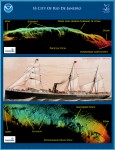 Last month, scientists from the National Oceanic and Atmospheric Administration (NOAA) set out to find the City of Rio as part of a study of the shipwrecks in the Gulf of the Farallones National Marine Sanctuary. Equipped with a powerful remotely operated vehicle, a 3D sonar and experts to run them, the team was able to identify the City of Rio 287 feet under the surface just outside the Golden Gate inside the main ship channel.
Last month, scientists from the National Oceanic and Atmospheric Administration (NOAA) set out to find the City of Rio as part of a study of the shipwrecks in the Gulf of the Farallones National Marine Sanctuary. Equipped with a powerful remotely operated vehicle, a 3D sonar and experts to run them, the team was able to identify the City of Rio 287 feet under the surface just outside the Golden Gate inside the main ship channel.
The 3-D model generated by the Coda Octopus “Echoscope” sonar also gave researchers an entirely new perspective on the condition of the wreck site. What they found was a crumpled, scarcely recognizable iron hulk encased in more than a century worth of mud and sediment, lending support to the narrative that the ship sank quickly before many of its passengers could escape.
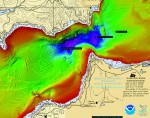 While they were in the area, the research team also used the 3D sonar to remap the wreck of the City of Chester that was found in 2013. The Echoscope found that the City of Chester is in far better condition, with the ship’s frame and propulsion machinery still well preserved. It went down in a collision with another ship and unlike the City of Rio, its engine room didn’t explode after it sank.
While they were in the area, the research team also used the 3D sonar to remap the wreck of the City of Chester that was found in 2013. The Echoscope found that the City of Chester is in far better condition, with the ship’s frame and propulsion machinery still well preserved. It went down in a collision with another ship and unlike the City of Rio, its engine room didn’t explode after it sank.
The NOAA’s Office of National Marine Sanctuaries Maritime Heritage Program will continue the map the wrecks in the Gulf of the Farallones National Marine Sanctuary and the Golden Gate National Recreation Area. So far they’ve documented nine of them. Almost 200 ships have gone down in San Francisco Bay, so there are plenty more to be found. None of them will be interfered with beyond the mapping of them as they are maritime graves.
